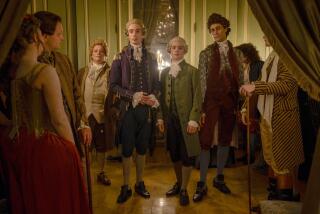The Ties That Bind Them
- Share via
What do Abraham Lincoln, Stan Laurel, Harry Truman, Frank Sinatra, Karl Marx, Steve Jobs, Winston Churchill, Donald Duck, Mark Twain, Frederick Rasmussen, Manet’s “Olympia,” Louis Farrakhan and virtually the entire male membership of the Nation of Islam have in common?
Well, bow ties, of course.
Olympia’s admittedly is only a bit of string, but, then again, that’s about all she wears except for a bracelet, a pair of bedroom slippers and a hibiscus bloom in her hair.
Farrakhan and his followers mostly wear narrow straight-edge bow ties, usually red or black, although the minister often wears the more assertive butterfly style.
Marx’s beard often obscured his.
Churchill, Great Britain’s World War II prime minister, invariably wore the traditional butterfly in a conservative white polka dot on a navy background, befitting his Conservative politics.
Duck favored an uninhibited red.
“The bow tie wearer wants to be a little bit different,” says Kirk E. Hinckley, 33-year-old entrepreneur and president of the international Bow Tie Club catalog. “They want to be distinct. They’re proud of their difference. And they’re showing it through their bow tie. The type of individual who wears the bow tie is a very autonomous person--a doctor, a lawyer, a professor.”
A duck.
Pediatricians love bow ties, he says.
They don’t get in the way, and babies can’t play with them.
Architects love them too. “They want to look structurally different,” says Hinckley.
The Bow Tie Club, he says, derives from the camaraderie shared by bow
tie wearers: “It’s a club where all you have to do to be a member is wear a bow tie.”
The “club” is actually a commercial venture launched three years ago by Hinckley, who earned an MBA from the University of Baltimore and has worked in the shirt and tie departments at Brooks Bros. Joseph Bank and Nordstrom. Bow
ties, he felt, seemed an afterthought.
“We were treating the bow tie wearer as a
second-class citizen,” he says, which is definitely not how bow tie wearers think of themselves. “You look at bow tie wearers, you know that person has confidence and control of their life. . . . They can be a little bit different and be independent.”
Hinckley, a native of California who lives in Silver Spring, Md., imports the silk for his ties from Italy. He and his fiancee, Corinne Hsu, cut the patterns, then send the silk off to Baltimore seamstresses to be finished.
The couple ship the finished ties to customers all over the United States and to about 20 other countries. He figures they sell 3,000 to 4,000 ties a year.
Hinckley advertises his current collection in the New Yorker, Smithsonian, Johns Hopkins Magazine and Civilization, the magazine of the Library of Congress, which brings the best response. (Bow tie wearers are nothing if not civilized.)
Although bow ties fall in and out of favor
in the fashion world, Hinckley concedes that, even when they are popular, they will never dominate the market.
“So in terms of people saying, ‘Well, are bow ties dying off?’ Absolutely not, absolutely not, they never will. There will always be new people who want something different in men’s clothing because there’s so little out there in terms of what is different.”
The bow tie, he says, “is a nice conservative way to show your distinction.”
More to Read
Sign up for Essential California
The most important California stories and recommendations in your inbox every morning.
You may occasionally receive promotional content from the Los Angeles Times.













